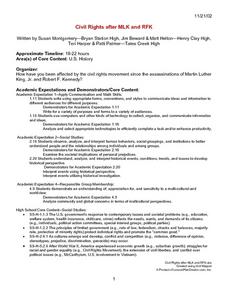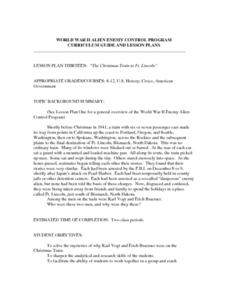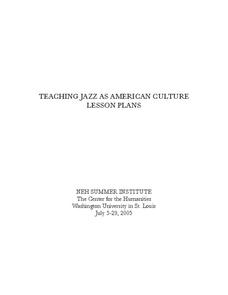Curated OER
Bill of Rights: Rights and Responsibilities
Students explore the meaning of freedom. In this U.S. History lesson, students research the Declaration of Independence and how it relates to American freedom by completing activities and a mock trial.
Curated OER
"Pressing" Issues In Zimbabwe
Students explore the nature of freedom of the press through examining a story about the capture and torture of journalists in Zimbabwe. They participate in a round-table discussion of the issues. They research an African country of their...
Curated OER
CIVICS/CURRENT EVENTS
Learners choose to either make an exhibit of posters of pictures about Darfur, or write a letter to the local newspaper regarding Darfur, or plan a concert, party, or bake sale to raise money for refugees. They write a poem defining...
Curated OER
Rationalizing Race in US History
Students consider the classification of people. In this race studies lesson, students examine the concept of race as it relates to U.S. history and trends. Students research racial discrimination and prejudice in order to support their...
Curated OER
Paul Robeson: 20th-Century Renaissance Man, Hero In Any Century
Students study the life and times of actor Paul Robeson. For this social activism lesson, students research primary and secondary documents to create multi-media presentations featuring Paul Robeson's life and political activism.
Curated OER
Youth and Children
Students investigate the rights that students possess while examining human rights in relation to bullying. They develop ideas and advice for conflict resolution between students.
Curated OER
Civil Rights after MLK and RFK
Pupils are assigned to groups representing minority populations who produce a research project in a digital format from the list. A few of the choices are: speech, letter to the editor, editorial cartoon, etc.
Curated OER
Seeking Civil Rights
Students explore the impact of the Plessy v. Ferguson case. In this social justice lesson plan, students examine the case, Jim Crow laws, and non-violent forms of protest. Students write essays to persuade the government regarding...
Curated OER
Jackie Robinson, Civil Rights Activist
Students analyze the life of Jackie Robinson and determine which characteristics contributed to his success as the baseball player who broke the color barrier and as a political activist.
Curated OER
The Fourth and Fifth Amendments: How Do They Protect Our Rights?
Students view a PowerPoint presentation on the fourth and fifth amendments. In this history activity, students explore the details of the fourth and fifth amendments and then answer questions that summarize the presentation.
Curated OER
Grass roots human rights
Students examine Professor Lowitja O'Donoghue's Ten Point Plan for Human Rights Action. They consider what initiatives they, as a group or as individuals, can take. Students analyze which human rights issues in Australia that they feel...
Curated OER
Human Rights
Middle schoolers create a working definition of human rights. They create a list of rights that are believed as mandatory for all human beings. The variety of rights the EU deems as necessary are taught to them.
Curated OER
Is This a Party Issue?
Students identify the differences between the two political parties as they stand on the issue of human rights. In groups, they examine the use of surveillance in the United States and how this can violate someone's human rights. They...
Curated OER
How Can You Be a Revolutionary?
Tenth graders identify priorities in human rights for children. They discuss the role the United Nations has in bringing nations together to work for peace and development. They create a list of imperatives that would address oversights...
Curated OER
The Christmas Train to Ft. Lincoln
Students solve the mysteries of why Karl Vogt and Erich Braemer were on the Christmas Train. They review the definitions of the terms constitutional, human rights, due process, discovery, and the writ of habeas corpus. They review the...
Atlanta History Center
Civil Disobedience and the Atlanta Student Movement
What tactics are used in civil disobedience? Learners study the conditions in Alabama that led to the establishment of the Atlanta Student Movement, as well as consider the nature and effectiveness of civil disobedience.
Washington University in St. Louis
Teaching Jazz as American Culture
Jazz and the City, Jazz and the Civil Rights Movement, Jazz and Gender, Jazz and Literature, Jazz and the Arts, Jazz and Film. Here's a packet of unit plans organized around themes that reflect American culture. Each unit examines how...
Facing History and Ourselves
Taking Ownership of the Law
The work of building and maintaining a democracy is, in the words of Justice William Hastie, "never finished." To better understand what Hastie sees as an ongoing building process, class members listen to a seven-minute podcast about two...
Curated OER
Just-Us and Kindness: A Voice for Children: King Day
Eighth graders investigate philanthropy. For this service learning lesson, 8th graders read human rights literature and use information gleaned to discuss children's rights around the world. Students discuss scenarios meant to prompt...
Advocates for Human Rights
The Rights of Migrants in the United States Lesson Plan: Traveling Suitcases
Two activities bridge English language arts and social studies to take an inside look into immigration. Scholars interview a family member or someone they know who immigrated here. A crafted suitcase features information obtained in the...
Curated OER
My Home is Not Your Home
Young scholars examine tension in Slovakia over issue of the rights of Romas (Gypsies). They compare and contrast situation in Slovakia to other historical examples researched in class.
Curated OER
The Nervous System
Young scholars investigate the nervous system. For this anatomy lesson, students identify and define vocabulary related to the nervous system. Young scholars role play the parts of a nervous system and perform an experiment...
Baylor College
Pre-Assessment: The Brain
Break your class in to the general structure and function of the brain. Brainiacs discuss what they know about it and create personalized brain development timelines. They also take a true-false, pre-assessment quiz to get them thinking...
Baylor College
Drugs, Risks and the Nervous System
In cooperative groups, middle schoolers contemplate the probability of 18 different situations occurring. After they make predictions, they compare them to the actual risk factors. This eye-opening exercise demonstrates that the odds of...
Other popular searches
- Bill of Human Rights
- Human Rights Environment
- Human Rights Lesson
- Human Rights Poster
- Human Rights Violations
- Canadian Human Rights
- Declaration of Human Rights
- Human Rights Abuses
- Latin America Human Rights
- Human Rights Issue
- Human Rights Activists
- Human Rights Groups

























